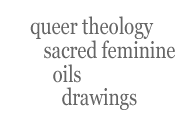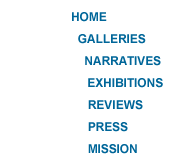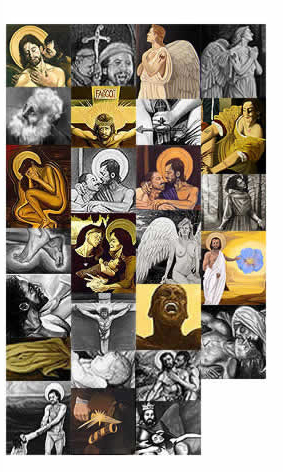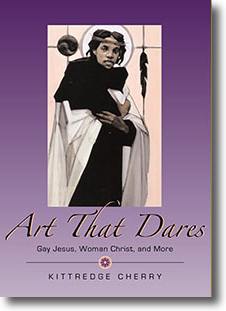



Lesbian Leonardo uses history to make history
Harrelson’s queer Christian images empower lesbian, gay, bisexual and transgender (LGBT) people and our allies.BY KITTREDGE CHERRY
Becki Jayne Harrelson uses history to make history. She emulates great artists of the past to make art of lasting value on contemporary themes. The Atlanta artist is rightly called “the lesbian Leonardo Da Vinci” because her prodigious talent, style and subject matter are reminiscent of the great Renaissance artist.
Harrelson’s queer Christian images empower lesbian, gay, bisexual and transgender (LGBT) people and our allies. Her breakthrough iconography is badly needed now because conservatives are misusing religious rhetoric to justify discrimination against LGBT people -- even though Jesus taught love for all.
Critics praise her “skilled execution,” and her work has been exhibited at galleries in New York City and Taos, NM. Her art stirs such passions that most galleries won’t show it, yet she has gained worldwide following, thanks to the Internet and a few brave collectors who stand up for artistic and religious freedom.
Her masterpiece is “Crucifixion of the Christ,” better known as the “faggot crucifixion” because the sign on the cross above Jesus reads “faggot.” Harrelson’s main point is not that Jesus was gay. In her view, to take her literally would be to make the same mistake as taking the Bible literally. “In Western civilization, Jesus is THE ideal of holiness, of perfection in the flesh. My purpose is to de-shame our human sexual natures, especially gay sexuality, and present it as a sacred act,” she explains.
The journey that led Harrelson to re-envision the crucifixion illustrates her authenticity, audacity, and insight. She grew up in a Christian fundamentalist family full of Baptist and Pentecostal ministers. When she came out to her mother as a lesbian in 1985, she was called “demon-possessed” and warned about going to hell. She kept struggling with her family’s homophobia and her own childhood abuse memories until she had a spiritual breakthrough in 1991. Her gay Christ images were conceived during that healing crisis, but even she found them so shocking that she tried to suppress them for years.
Finally her potent mix of rage, religion, memory, sex, and politics swirled together and pushed her to put the images on canvas. She took the wealth of Christian wisdom that she had learned from her family, and crafted it into a transformative message that was true to her own lesbian experience.

Harrelson helped give birth to a whole new genre of art in 1993 when she painted “Judas Kiss,” which shows Jesus in a homoerotic embrace. She followed up with an ambitious series that re-envisions Bible stories from a lesbian feminist viewpoint. It includes the Madonna with her female lover, Jesus rescuing a drag queen from stoning, a female Holy Spirit raising Christ from the dead—and, of course, the “faggot crucifixion.” Harrelson and a handful of other visionaries have continued to create queer Christian art over the years.
Drawing inspiration from Salvador Dali’s surrealist “Crucifixion,” Harrelson painted her crucifixion through a steady stream of tears over human cruelty. “Look at the word ‘faggot’ on the cross. You could substitute the word ‘nigger,’ ‘Jew boy,’ ‘honkie,’ ‘redneck’ or ‘bitch’—it all means the same. Anytime anyone rises up in condemnation, hatred, or violence against another, Christ is crucified,” she said.
Plenty of people rose up to condemn the painting. “That is sick and disgusting,” is a typical comment on conservative Christian websites where the “faggot crucifixion” has been viciously denounced. Harrelson’s queer Christian art has been de facto censored in her hometown of Atlanta. Even gay gallery owners rejected it for fear of broken windows or worse.
Attacks also came from inside the queer community. Many appreciated her art, but some considered all Christian imagery to be inherently homophobic. Some said slurs like “faggot” should never be used. Some lesbians complained that she shouldn’t paint men.
Harrelson no longer calls herself Christian or puts any other label on her spirituality. She does connect to what she calls “the Source” by making art. She begins each painting with a sanctifying ritual that includes prayer, music, incense, and anointing the canvas with oil. All her models are lesbians and gay men in real life.
Self-taught as an artist, Harrelson studied the work of Da Vinci, Rembrandt, Michelangelo, and Caravaggio, as well as modern masters. Then she let the process of making art teach her. References to their work and visual puns are hidden on her canvases for those with eyes to see.
Harrelson is also a versatile Renaissance woman who excels in many different fields: art, writing, marketing, advertising, graphic design, and web design and development. She speaks with quicksilver eloquence and a slight Southern drawl. A self-proclaimed “lipstick lesbian,” she nonetheless usually runs around in “artist ragtag clothes” without makeup. She worked her way up to senior account manager for Mobil Chemical Company at an Atlanta ad agency, then left in 1991 to pursue art and writing. When she’s not “art-ing,” as she calls it, Harrelson relaxes by writing political commentary or composing music.
Her paintings function on multiple levels. In “Judas Kiss,” Jesus and his betrayer embrace in a time warp that is both Gethsemane and a contemporary gay cruising ground strewn with a beer can and a naked couple. “The Last Supper” is a tribute to Da Vinci’s masterpiece of the same name, with disciples that include a Bacchus-like drag queen based on the work of Caravaggio. Their excesses are balanced by love, represented by Jesus and his Beloved in the center.
Each painting is packed with buried treasures for those who stay to study the details. For example, “Madonna, Lover and Son” is set in the same landscape as Da Vinci’s “Madonna of the Rocks.” In Harrelson’s version, the Madonna has a classic stylized halo while the landscape forms a natural sunlit halo around her blonde lover (based on the woman who has been Harrelson’s partner since 1995). The contrasting halos are Harrelson’s way of saying that lesbians are a natural part of creation, as opposed to the roles of wife and mother imposed by patriarchal religion. A turkey baster is concealed in the bushes, a play on artificial insemination and virgin birth.
Harrelson was the most obvious choice to include in my book “Art That Dares: Gay Jesus, Woman Christ, and More.” Her work precedes and sheds light on virtually every other queer image of Christ. Harrelson was more than generous in sharing her art from the start of the book project, revealing a holy passion that shines through her art to enlighten those who behold it.
Rev. Kittredge Cherry is a lesbian Christian author, minister and art historian who offers gay-friendly spiritual resources at JesusInLove.org. Ordained by Metropolitan Community Churches (MCC), Kitt was at the forefront of the homosexuality debates at the National Council of Churches (USA) and the World Council of Churches as MCC's National Ecumenical Officer.
Books by Kitt CherryA Lambda Literary Award Finalist (2007)
Art That Dares: Gay Jesus, Woman Christ And More
Read Amazon Customer Reviews about the book.
RECENT BOOK RELEASE:
Passion of Christ: A Gay Vision
Read what others are saying about the book. Includes color plates of paintings by Douglas Blanchard.
OTHER BOOKS BY KITT CHERRY:
Jesus In Love
At The Cross (Jesus In Love)
Hide and Speak: A Coming Out Guide
Equal Rites: Lesbian and Gay Worship, Ceremonies and Celebrations
Womansworld: What Japanese Words Say About Women
KITT CHERRY'S BLOG:
Jesus In Love Blog